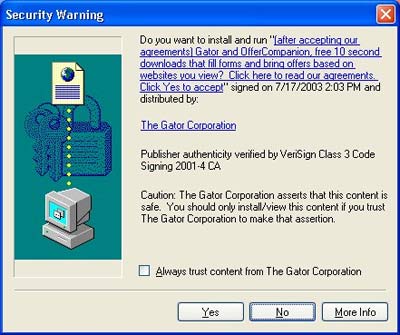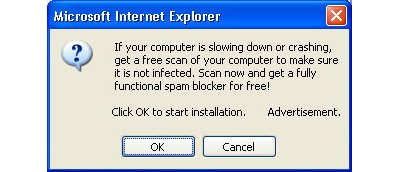Spyware usually gets onto your machine because of
something you do, like clicking a button on a pop-up window, installing a
software package or agreeing to add functionality to your Web browser. These
applications often use trickery to get you to install them, from fake system
alert messages to buttons that say "cancel" when they really do the opposite.
Here are some of the general ways in which Spyware finds its way into your
computer:
- Piggybacked software installation - Some applications --
particularly
peer-to-peer file-sharing clients -- will install spyware as a part of
their standard install. If you don't read the installation list closely, you
might not notice that you're getting more than the file-sharing application
you want. This is especially true of the "free" versions that are advertised
as an alternative to software you have to buy. There's no such thing as a free
lunch.
|

Courtesy © Sharman Networks 2002-2004 - All Rights Reserved.
While it officially claims otherwise, Kazaa has been
known to include spyware in its download package.
|
- Drive-by download - This is when a Web site or pop-up window
automatically tries to download and install spyware on your machine. The only
warning you might get would be your browser's standard message telling you the
name of the software and asking if it's okay to install it.
|

Photo courtesy
Internet Explorer security warning
|
If your security settings are set low enough, you won't even get the warning.
- Browser add-ons - These are pieces of software that add
enhancements to your Web browser, like a toolbar, animated pal or additional
search box. Sometimes, these really do what they say they do but also include
elements of spyware as part of the deal. Or sometimes they are nothing more
than thinly veiled spyware themselves. Particularly nasty add-ons are
considered browser hijackers -- these embed themselves deeply in your
machine and take quite a bit of work to get rid of.
|

Photo courtesy
Bonzi Buddy is an "add-on" application that includes
spyware in its package.
|
- Masquerading as anti-spyware - This is one of the cruelest tricks
in the book. This type of software convinces you that it's a tool to detect
and remove spyware.
When you run the tool, it tells you your computer is clean while it
installs additional spyware of its own.



